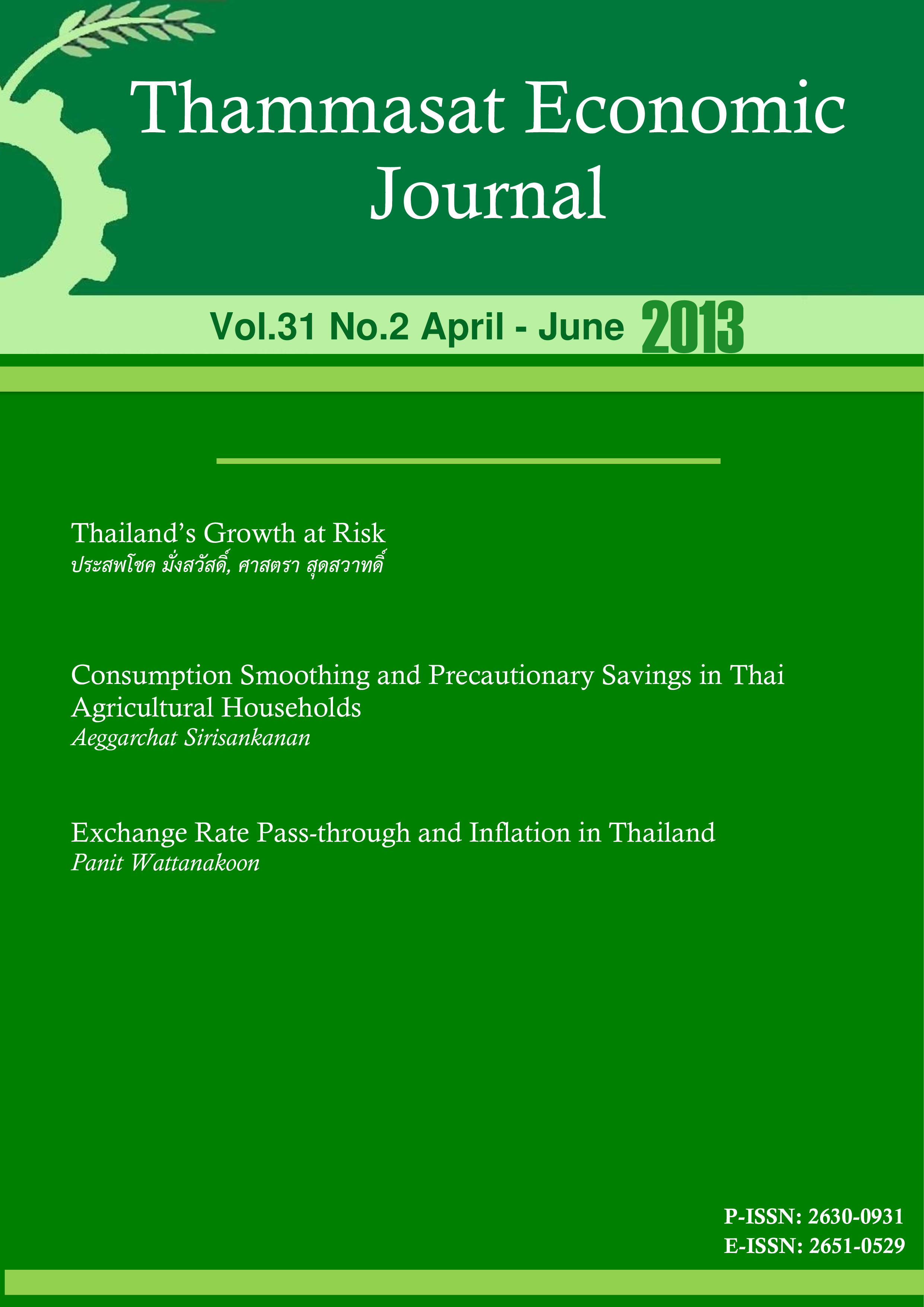Exchange Rate Pass-through and Inflation in Thailand
Keywords:
Pass-through, Foreign Exchange Policy, Macroeconomic StabilityAbstract
This paper examines the extent to which exchange rate changes affect domestic prices, using the experience of Thailand from January, 2000 to August, 2011. The standard Engle-Granger two-step estimation is applied. Our main finding is that, inevitably, a change in exchange rate will affect inflation incompletely. One per cent of currency depreciation causes an increase in price level of 0.02 per cent in the short run. Its effect is larger in the long run: 0.4. The low degree of pass-through especially in the short-run is due to government reaction to curb the adverse effect of an inflation threat on cost of living. The limited side effect of exchange rate changes on price stability as found in this paper could be used as input in managing exchange rate policy in Thailand.
References
2.Barhoumi, K. and Jouini, J., (2008). “Revisiting the Decline in the Exchange Rate Pass-Through: Further Evidence from Developing Countries,” Document de travail 213, Banque de France.
3.Bai, J., and P. Perron (1998). “Estimating and testing linear models with multiple structural changes”, Econometrica 66, 47-78
4.Campa, J. M. and Goldberg, L. S. (2002). “Exchange Rate Pass-through into Import Prices: A Macro or Micro Phenomenon?.” NBER Working Paper Series 8934, May
5.Chai-anant, C., Pongsaparn R. and Tansuwanarat K. (2008). “Role of Exchange Rate in Monetary Policy under Inflation Targeting: a Case Study of Thailand,” Bank of Thailand Symposium, September.
6.Dwyer, J., Kent, C. and Pease, A. (1993). “Exchange Rate Pass-through: The Different Responses of Importers and Exporters,” Research Discussion Paper Economic Research Department Reserve Bank of Australia, 9304, May
7.Engle, Robert F. and Granger, Clive W. J. (1987). “Co-integration and Error Correction: Representation, Estimation and Testing”. Econometrica 55 (2): 251–276
8.Erceg, Christopher J., Luca Guerrieri, and Christopher Gust (2006). “SIGMA: A New Open Economy Model for Policy Analysis,” International Journal of Central Banking, vol. 2 (March),pp. 1-50.
9.Granger, C.W.J. and P. Newbold (1974), ‘Spurious Regressions in Econometrics’, Journal of Econometrics, 2(2): 111-20.
10.Gregory, A., and B.E. Hansen (1996). “Residual-based tests for Cointegration in Models with Regime Shifts,” Journal of Econometrics 70, 99-126.
11.Hooper, Peter Mann, and Catherine L., (1989). "Exchange Rate Pass-through in the 1980s: The Case of U.S. Imports of Manufactures," Brookings Papers on Economic Activity, Economic Studies Program, The Brookings Institution, vol. 20(1989-1), pages 297-337.
12.Jitpokkasame, Pakin (2007). “Exchange Rate Pass through Consumer Price in Thailand,” Master of Economics, Faculty of Economics, Thammasat Univerisity
13.Kiptui M., Ndolo, D. and Kaminchia S. (2005). “Exchange Rate Pass-through: To What Extent Do Exchange Rate Fluctuations Affect Import Prices and Inflation in Kenya?,” Working Paper No.1, Central Bank of Kenya, April
14.Kohpaiboon, A. (2006) Multinational Enterprises and Industrial Transformation: Evidence from Thailand, Cheltenham: Edward Elgar.
15.Korhonen, L. and Wachtel, P., 2005. “A Note on Exchange Rate Pass-through in CIS Countries,” Bank of Finland Discussion Papers 2
16.Mallikamas, Roong Poshyananda and Pongsaparn, Runchana (2005). “Evolving Inflation Process: The Thai Experience,” BIS Autumn 2005 Central Bank Economists’ Meeting, Basel, Switzerland, 27-28, October.
17.Menon, J. (1996). “Exchange Rates and Prices: The Case of Australian Manufactured Imports,” Springer.
18.Mills, T.C. (1990), Time Series Techniques for Economists, Cambridge: Cambridge University Press.
19.Mishkin, Frederic S., (2008). “Exchange Rate Pass-Through and Monetary Policy,” NBER Working Papers 13889, National Bureau of Economic Research.
20.Nelson, C. R. and C. I. Plosser (1982), ‘Trends and Random Walks in Macroeconomic Time Series: Some Evidence and Implications’, Journal of Monetary Economics, 10(1): 139-62.
21.Razafimahefa, Ivohasina F. (2012). “Exchange Rate Pass-Through in Sub-Saharan African Economies and its Determinants,” IMF Working Paper, International Monetary Fund.
22.Sekine, T. 2006. “Time-Varying Exchange Rate Pass-Through: Experiences of Some Industrial Countries.” Bank for International Settlements Working Paper 202.
23.Taylor, J. (2000). “Low inflation, pass-through, and the pricing power of firms,” European Economic Review 44, 1389-1408.
24.Wickremasinghe, Guneratne Banda and Silvapulle, Param (2004). “Exchange Rate Pass-Through to Manufactured Import Prices: The Case of Japan,” International Trade, Econ WPA.










